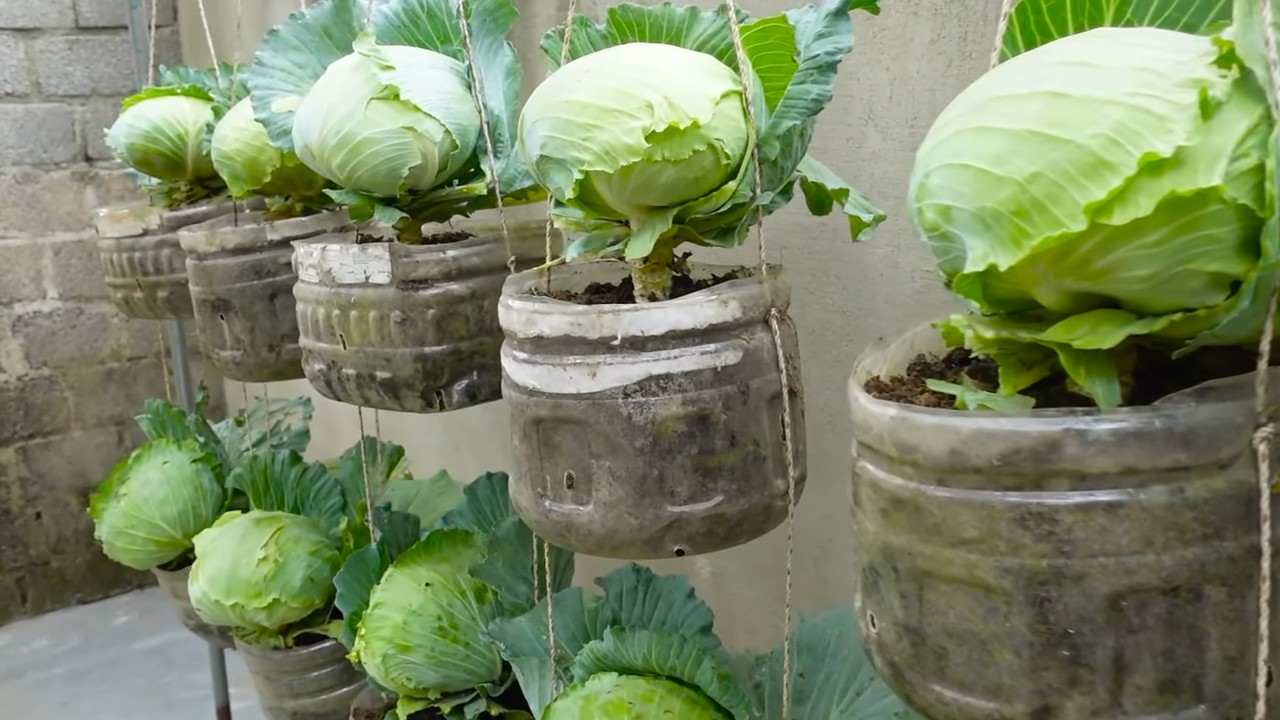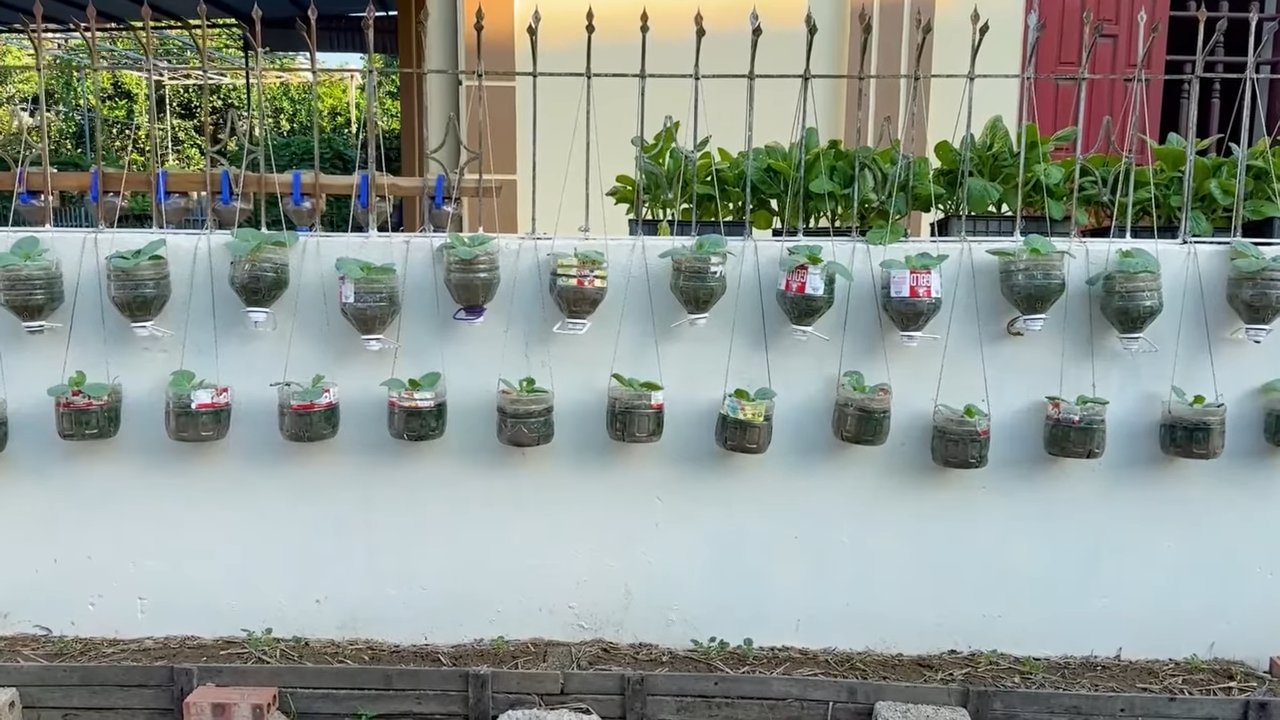Vertical Cabbage Growing: Tired of battling garden pests and limited space for your beloved cabbages? I get it! We’ve all been there, dreaming of a lush garden overflowing with fresh produce, only to be met with the realities of cramped quarters and hungry critters. But what if I told you there’s a way to bypass these common gardening woes and cultivate a thriving cabbage patch, even if you only have a balcony or small patio?
For centuries, humans have cultivated cabbage, a staple in diets across the globe. From ancient Roman feasts to hearty Eastern European stews, this humble vegetable has nourished generations. But traditional cabbage growing can be demanding, requiring ample ground space and constant vigilance against pests. That’s where the magic of vertical gardening comes in!
This DIY guide is your passport to a bountiful harvest of crisp, delicious cabbages, all grown vertically! Imagine the satisfaction of snipping fresh leaves right outside your kitchen door, knowing you nurtured them from seedling to table. We’ll explore simple, cost-effective methods for vertical cabbage growing, transforming your limited space into a verdant oasis. Say goodbye to backaches from weeding and hello to a thriving, space-saving garden. Let’s get started and unlock the secrets to a successful vertical cabbage harvest!

DIY Vertical Cabbage Growing Tower: Maximize Your Harvest in Minimal Space
Hey there, fellow gardening enthusiasts! Are you dreaming of a bountiful cabbage harvest but short on garden space? Well, I’ve got just the project for you: a DIY vertical cabbage growing tower! This ingenious setup allows you to grow a surprising amount of cabbage in a small footprint, making it perfect for balconies, patios, or even small backyards. Plus, it’s a fun and rewarding project that will impress your neighbors. Let’s get started!
What You’ll Need
Before we dive in, let’s gather all the necessary materials. This will save you time and frustration later on.
* **Large Plastic Container (Food-Grade):** A 55-gallon plastic drum or a large, sturdy storage container works great. Make sure it’s food-grade to avoid any harmful chemicals leaching into your soil.
* **Smaller Plastic Pots (Various Sizes):** You’ll need a variety of smaller pots, ranging from 4-inch to 6-inch diameter, depending on the size of your cabbage varieties. Aim for at least 10-15 pots.
* **PVC Pipe (4-inch Diameter):** This will form the central support and watering system for your tower. The length should be slightly shorter than the height of your container.
* **PVC End Cap:** To seal the bottom of the PVC pipe.
* **Drill with Various Drill Bits:** You’ll need a standard drill bit for making drainage holes and a larger hole saw (around 4-inch diameter) for creating planting holes in the container.
* **Landscape Fabric or Burlap:** To line the inside of the container and prevent soil from washing out.
* **Potting Mix:** A high-quality potting mix is crucial for healthy cabbage growth.
* **Cabbage Seedlings:** Choose your favorite cabbage varieties! Consider different colors and sizes for a visually appealing tower.
* **Measuring Tape or Ruler:** For accurate measurements.
* **Utility Knife or Scissors:** For cutting landscape fabric and PVC pipe (if needed).
* **Gloves:** To protect your hands.
* **Safety Glasses:** Always wear safety glasses when drilling or cutting.
* **Optional: Compost or Worm Castings:** To enrich the potting mix.
* **Optional: Slow-Release Fertilizer:** To provide a steady supply of nutrients.
Building Your Vertical Cabbage Tower: Step-by-Step
Alright, let’s get our hands dirty! Follow these steps carefully to construct your vertical cabbage growing tower.
1. **Prepare the Container:**
* First, clean the plastic container thoroughly with soap and water. Rinse well to remove any residue.
* Next, line the inside of the container with landscape fabric or burlap. This will help retain moisture and prevent soil from escaping through the drainage holes. Cut the fabric slightly larger than the container’s interior and secure it with staples or glue (optional).
* Drill drainage holes in the bottom of the container. Space them about 6-8 inches apart.
2. **Prepare the PVC Pipe:**
* Cap one end of the PVC pipe with the PVC end cap. This will prevent soil from entering the pipe.
* Drill small holes (about 1/4-inch diameter) along the length of the PVC pipe. These holes will allow water to seep out and irrigate the cabbage plants. Space the holes about 4-6 inches apart, focusing on the areas where the plants will be located.
* Consider staggering the holes in a spiral pattern around the pipe for even water distribution.
3. **Position the PVC Pipe:**
* Place the PVC pipe in the center of the container, with the capped end resting on the bottom.
* Make sure the pipe is stable and upright. You can use rocks or bricks to temporarily hold it in place.
4. **Create Planting Holes:**
* This is where the magic happens! Using the hole saw, drill planting holes around the sides of the container.
* Space the holes about 8-12 inches apart, both vertically and horizontally. The size of the holes should be slightly smaller than the diameter of your smaller plastic pots. This will allow the pots to fit snugly into the holes.
* Start drilling the holes near the bottom of the container and work your way up.
* Be careful not to drill too close to the bottom or top edges of the container.
5. **Fill the Container with Potting Mix:**
* Slowly fill the container with potting mix, working around the PVC pipe.
* As you fill, gently pack the soil around the pipe to provide support.
* Mix in compost or worm castings to enrich the soil and provide extra nutrients.
* Leave about 2-3 inches of space at the top of the container.
6. **Insert the Pots:**
* Now, insert the smaller plastic pots into the planting holes you created.
* Make sure the pots fit snugly and are securely in place.
* Fill each pot with potting mix.
7. **Plant Your Cabbage Seedlings:**
* Carefully remove the cabbage seedlings from their original containers.
* Gently loosen the roots before planting.
* Plant one cabbage seedling in each pot.
* Water the seedlings thoroughly after planting.
8. **Watering and Maintenance:**
* Water your cabbage tower regularly, especially during hot and dry weather.
* Pour water directly into the top of the PVC pipe. The water will seep out through the holes and irrigate the plants.
* You can also water the plants directly in the pots.
* Fertilize your cabbage plants regularly with a balanced fertilizer. Follow the instructions on the fertilizer package.
* Monitor your plants for pests and diseases. Take action promptly if you notice any problems.
* Remove any dead or yellowing leaves.
Optimizing Your Cabbage Tower for Success
To ensure a thriving cabbage tower, consider these additional tips:
* **Sunlight:** Cabbage needs at least 6 hours of sunlight per day. Place your tower in a sunny location. If you don’t have enough sunlight, you can supplement with grow lights.
* **Soil:** Use a well-draining potting mix that is rich in organic matter. Amend the soil with compost or worm castings to provide extra nutrients.
* **Watering:** Cabbage needs consistent moisture. Water deeply and regularly, especially during hot and dry weather. Avoid overwatering, which can lead to root rot.
* **Fertilizing:** Cabbage is a heavy feeder. Fertilize regularly with a balanced fertilizer. You can also use a slow-release fertilizer to provide a steady supply of nutrients.
* **Pest Control:** Cabbage is susceptible to several pests, including cabbage worms, aphids, and flea beetles. Monitor your plants regularly and take action promptly if you notice any problems. You can use organic pest control methods, such as insecticidal soap or neem oil.
* **Disease Control:** Cabbage can also be affected by diseases, such as black rot and clubroot. Choose disease-resistant varieties and practice good sanitation to prevent disease problems.
* **Variety Selection:** Choose cabbage varieties that are well-suited to your climate and growing conditions. Consider different colors and sizes for a visually appealing tower.
* **Rotation:** If possible, rotate your cabbage tower each year to prevent soilborne diseases.
* **Support:** As the cabbage heads grow larger, they may need additional support. You can use stakes or cages to support the plants.
* **Harvesting:** Harvest your cabbage when the heads are firm and fully developed. Cut the heads off at the base of the plant.
Troubleshooting Common Issues
Even with the best planning, you might encounter a few challenges. Here’s how to tackle them:
* **Yellowing Leaves:** This could indicate overwatering, underwatering, nutrient deficiency, or pest infestation. Check the soil moisture, fertilize if needed, and inspect for pests.
* **Slow Growth:** Insufficient sunlight, poor soil, or lack of nutrients can cause slow growth. Ensure your tower gets enough sunlight, amend the soil, and fertilize regularly.
* **Pest Infestation:** Treat infestations promptly with organic pest control methods like insecticidal soap or neem oil.
* **Root Rot:** Overwatering can lead to root rot. Ensure proper drainage and allow the soil to dry slightly between waterings.
Enjoying Your Vertical Cabbage Harvest
After all your hard work, it’s time to reap the rewards! Harvesting your own homegrown cabbage is incredibly satisfying. Use your fresh cabbage in salads, slaws, soups, stir-fries, or fermented dishes like sauerkraut. The possibilities are endless!
I hope this guide has inspired you to create your own vertical cabbage growing tower. It’s a fantastic way to maximize your harvest in a small space and enjoy fresh, homegrown cabbage all season long. Happy gardening!

Conclusion
So, there you have it! Vertical cabbage growing isn’t just a quirky gardening trend; it’s a game-changer for maximizing space, improving plant health, and ultimately, enjoying a more bountiful harvest. We’ve explored the ins and outs of this innovative technique, from choosing the right container to providing optimal care for your leafy greens.
But why is this DIY trick a must-try? Let’s recap. First and foremost, it’s incredibly space-efficient. Whether you have a sprawling backyard or a tiny balcony, vertical cabbage growing allows you to cultivate a surprising amount of produce in a minimal footprint. This is especially crucial for urban gardeners or anyone looking to make the most of limited resources.
Secondly, vertical systems often lead to healthier plants. Improved air circulation around the leaves reduces the risk of fungal diseases, a common problem with traditional ground-level gardening. Plus, it’s easier to control pests and weeds when your cabbages are elevated and contained.
Thirdly, and perhaps most importantly, it’s incredibly rewarding! There’s something deeply satisfying about nurturing your own food from seed to table, and vertical cabbage growing makes the process even more accessible and enjoyable. Imagine stepping outside your door to harvest fresh, crisp cabbage for salads, slaws, or hearty winter stews.
Ready to take your vertical garden to the next level? Consider these variations:
* Experiment with different container types: While we’ve focused on stackable planters and repurposed materials, you could also try using hanging baskets, pallet gardens, or even DIY towers made from PVC pipes. Each option offers its own unique aesthetic and practical advantages.
* Explore companion planting: Enhance your vertical cabbage garden by incorporating companion plants like marigolds (to deter pests), dill (to attract beneficial insects), or chamomile (to improve overall plant health).
* Try different cabbage varieties: Don’t limit yourself to just one type of cabbage! Experiment with different colors, shapes, and flavors to create a diverse and visually appealing vertical garden. Red cabbage, savoy cabbage, and even ornamental cabbages can add interest and variety.
* Consider adding an automated watering system: For busy gardeners, a simple drip irrigation system can be a lifesaver. It ensures that your cabbages receive consistent moisture, even when you’re away.
Now it’s your turn! We encourage you to embrace the world of vertical cabbage growing and discover the many benefits it has to offer. Don’t be afraid to get creative, experiment with different techniques, and adapt the methods to suit your specific needs and preferences.
Most importantly, share your experiences with us! We’d love to hear about your successes, challenges, and innovative ideas. Post photos of your vertical cabbage gardens on social media using #VerticalCabbageGrowing and tag us so we can see your amazing creations. Let’s build a community of passionate gardeners who are dedicated to maximizing space, minimizing waste, and enjoying the delicious rewards of homegrown produce. Happy growing!
Frequently Asked Questions (FAQ)
What are the best cabbage varieties for vertical growing?
While most cabbage varieties can be grown vertically, some are better suited than others. Compact varieties like ‘Golden Acre,’ ‘Dwarf Blue Vates,’ and ‘Red Express’ tend to thrive in containers due to their smaller size and shorter growing season. These varieties are less likely to become top-heavy and require less support. However, don’t be afraid to experiment with larger varieties if you have a sturdy vertical system and are willing to provide extra support. Consider the mature size of the cabbage head when choosing your varieties to ensure they fit comfortably within your chosen container.
How much sunlight do vertical cabbages need?
Cabbages are sun-loving plants and require at least 6 hours of direct sunlight per day to thrive. When setting up your vertical garden, choose a location that receives ample sunlight throughout the day. If you live in a particularly hot climate, consider providing some afternoon shade to prevent the leaves from scorching. If you don’t have access to enough natural sunlight, you can supplement with grow lights. Position the grow lights close to the plants and adjust the height as they grow to ensure they receive adequate light.
What type of soil is best for vertical cabbage growing?
Cabbages prefer well-draining, fertile soil that is rich in organic matter. A good potting mix specifically formulated for vegetables is ideal. Avoid using garden soil, as it can be too heavy and compact, hindering drainage and root growth. Amend your potting mix with compost or other organic materials to improve its fertility and water-holding capacity. A slightly acidic to neutral pH (around 6.0 to 7.0) is optimal for cabbage growth. You can test your soil’s pH using a soil testing kit and adjust it accordingly with lime or sulfur.
How often should I water my vertical cabbages?
Watering frequency will depend on several factors, including the weather, the type of container you’re using, and the size of your plants. Generally, you should water your vertical cabbages whenever the top inch of soil feels dry to the touch. Water deeply and thoroughly, ensuring that the water drains out of the bottom of the container. Avoid overwatering, as this can lead to root rot. During hot, dry weather, you may need to water your cabbages daily. Consider using a moisture meter to accurately assess the soil’s moisture level.
How do I fertilize my vertical cabbages?
Cabbages are heavy feeders and require regular fertilization to produce large, healthy heads. Start by incorporating a slow-release fertilizer into your potting mix at planting time. Then, supplement with a liquid fertilizer every 2-3 weeks throughout the growing season. Choose a fertilizer that is high in nitrogen, phosphorus, and potassium (NPK). Follow the instructions on the fertilizer label carefully to avoid over-fertilizing, which can damage your plants. You can also use organic fertilizers like compost tea or fish emulsion.
How do I protect my vertical cabbages from pests and diseases?
Vertical growing can help reduce the risk of pests and diseases, but it’s still important to take preventative measures. Regularly inspect your plants for signs of pests like aphids, cabbage worms, and slugs. Handpick any pests you find or use organic pest control methods like insecticidal soap or neem oil. To prevent diseases, ensure good air circulation around your plants and avoid overwatering. Remove any diseased leaves promptly to prevent the spread of infection. Consider using companion plants like marigolds or dill to deter pests and attract beneficial insects.
How long does it take for cabbages to mature in a vertical garden?
The time it takes for cabbages to mature will depend on the variety you’re growing and the growing conditions. Generally, cabbages take between 60 and 100 days to mature from seed. Check the seed packet or plant label for specific information on the maturity time for your chosen variety. Provide your cabbages with optimal growing conditions, including plenty of sunlight, water, and fertilizer, to ensure they mature quickly and produce large, healthy heads.
Can I grow cabbages vertically indoors?
Yes, you can grow cabbages vertically indoors, but you’ll need to provide them with adequate light. Use grow lights to supplement natural sunlight and ensure your cabbages receive at least 12-14 hours of light per day. Choose a well-ventilated location and monitor the temperature and humidity levels. Indoor growing can be a great option for extending the growing season or for gardeners who live in climates with harsh winters.
What are some common problems with vertical cabbage growing and how can I fix them?
Some common problems with vertical cabbage growing include:
* Yellowing leaves: This can be caused by nutrient deficiencies, overwatering, or underwatering. Adjust your watering and fertilization practices accordingly.
* Stunted growth: This can be caused by insufficient sunlight, poor soil, or pests. Ensure your cabbages receive adequate sunlight, use a high-quality potting mix, and control pests.
* Bolting (premature flowering): This can be caused by stress, such as extreme temperatures or inconsistent watering. Provide your cabbages with consistent growing conditions and protect them from extreme weather.
* Root rot: This is caused by overwatering and poor drainage. Ensure your containers have adequate drainage holes and avoid overwatering.
By addressing these common problems promptly, you can ensure a successful vertical cabbage growing experience.




Leave a Comment